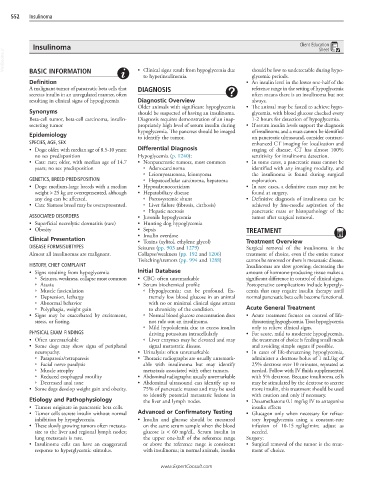Page 1109 - Cote clinical veterinary advisor dogs and cats 4th
P. 1109
552 Insulinoma
Insulinoma Client Education
Sheet
VetBooks.ir
• Clinical signs result from hypoglycemia due
BASIC INFORMATION
to hyperinsulinemia. should be low to undetectable during hypo-
glycemic periods.
Definition • An insulin level in the lower one-half of the
A malignant tumor of pancreatic beta cells that DIAGNOSIS reference range in the setting of hypoglycemia
secretes insulin in an unregulated manner, often often means there is an insulinoma but not
resulting in clinical signs of hypoglycemia Diagnostic Overview always.
Older animals with significant hypoglycemia • The animal may be fasted to achieve hypo-
Synonyms should be suspected of having an insulinoma. glycemia, with blood glucose checked every
Beta-cell tumor, beta-cell carcinoma, insulin- Diagnosis requires demonstration of an inap- 1-2 hours for detection of hypoglycemia.
secreting tumor propriately high level of serum insulin during • If serum insulin levels support the diagnosis
hypoglycemia. The pancreas should be imaged of insulinoma and a mass cannot be identified
Epidemiology to identify the tumor. on pancreatic ultrasound, consider contrast-
SPECIES, AGE, SEX enhanced CT imaging for localization and
• Dogs: older, with median age of 8.5-10 years; Differential Diagnosis staging of disease. CT has almost 100%
no sex predisposition Hypoglycemia (p. 1240): sensitivity for insulinoma detection.
• Cats: rare; older, with median age of 14.7 • Nonpancreatic tumors, most common • In some cases, a pancreatic mass cannot be
years; no sex predisposition ○ Adenocarcinoma identified with any imaging modality, and
○ Leiomyosarcoma, leiomyoma the insulinoma is found during surgical
GENETICS, BREED PREDISPOSITION ○ Hepatocellular carcinoma, hepatoma exploration.
• Dogs: medium-large breeds with a median • Hypoadrenocorticism • In rare cases, a definitive mass may not be
weight > 25 kg are overrepresented, although • Hepatobiliary disease found at surgery.
any dog can be affected. ○ Portosystemic shunt • Definitive diagnosis of insulinoma can be
• Cats: Siamese breed may be overrepresented. ○ Liver failure (fibrosis, cirrhosis) achieved by fine-needle aspiration of the
○ Hepatic necrosis pancreatic mass or histopathology of the
ASSOCIATED DISORDERS • Juvenile hypoglycemia tumor after surgical removal.
• Superficial necrolytic dermatitis (rare) • Hunting dog hypoglycemia
• Obesity • Sepsis TREATMENT
• Insulin overdose
Clinical Presentation • Toxins (xylitol, ethylene glycol) Treatment Overview
DISEASE FORMS/SUBTYPES Seizures (pp. 903 and 1279) Surgical removal of the insulinoma is the
Almost all insulinomas are malignant. Collapse/weakness (pp. 192 and 1206) treatment of choice, even if the entire tumor
Twitching/tremors (pp. 994 and 1288) cannot be removed or there is metastatic disease.
HISTORY, CHIEF COMPLAINT Insulinomas are slow growing; decreasing the
• Signs resulting from hypoglycemia Initial Database amount of hormone-producing tissue makes a
○ Seizures, weakness, collapse most common • CBC: often unremarkable significant difference in control of clinical signs.
○ Ataxia • Serum biochemical profile Postoperative complications include hypergly-
○ Muscle fasciculation ○ Hypoglycemia; can be profound. Ex- cemia that may require insulin therapy until
○ Depression, lethargy tremely low blood glucose in an animal normal pancreatic beta cells become functional.
○ Abnormal behavior with no or minimal clinical signs attests
○ Polyphagia, weight gain to chronicity of the condition. Acute General Treatment
• Signs may be exacerbated by excitement, ○ Normal blood glucose concentration does • Acute treatment focuses on control of life-
stress, or fasting. not rule out an insulinoma. threatening hypoglycemia. Treat hypoglycemia
○ Mild hypokalemia due to excess insulin only to relieve clinical signs.
PHYSICAL EXAM FINDINGS driving potassium intracellularly • For acute, mild to moderate hypoglycemia,
• Often unremarkable ○ Liver enzymes may be elevated and may the treatment of choice is feeding small meals
• Some dogs may show signs of peripheral signal metastatic disease. and avoiding simple sugars if possible.
neuropathy. • Urinalysis: often unremarkable • In cases of life-threatening hypoglycemia,
○ Paraparesis/tetraparesis • Thoracic radiographs are usually unremark- administer a dextrose bolus of 1 mL/kg of
○ Facial nerve paralysis able with insulinoma but may identify 25% dextrose over 10 minutes, repeated as
○ Muscle atrophy metastasis associated with other tumors. needed. Follow with IV fluids supplemented
○ Reduced esophageal motility • Abdominal radiographs: usually unremarkable with 5% dextrose. Because insulinoma cells
○ Decreased anal tone • Abdominal ultrasound can identify up to may be stimulated by the dextrose to secrete
• Some dogs develop weight gain and obesity. 75% of pancreatic masses and may be used more insulin, this treatment should be used
to identify potential metastatic lesions in with caution and only if necessary.
Etiology and Pathophysiology the liver and lymph nodes. • Dexamethasone 0.1 mg/kg IV to antagonize
• Tumors originate in pancreatic beta cells. insulin effects
• Tumor cells secrete insulin without normal Advanced or Confirmatory Testing • Glucagon only when necessary for refrac-
inhibition by hypoglycemia. • Insulin and glucose should be measured tory hypoglycemia using a constant-rate
• These slowly growing tumors often metasta- on the same serum sample when the blood infusion of 10-15 ng/kg/min; adjust as
size to the liver and regional lymph nodes; glucose is < 60 mg/dL. Serum insulin in needed.
lung metastasis is rare. the upper one-half of the reference range Surgery:
• Insulinoma cells can have an exaggerated or above the reference range is consistent • Surgical removal of the tumor is the treat-
response to hyperglycemic stimulus. with insulinoma; in normal animals, insulin ment of choice.
www.ExpertConsult.com

